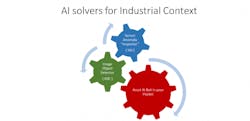The industrial world (oil and gas, utilities, refineries, discrete/continuous manufacturing) is in the early stages of radical transformation powered by artificial intelligence (AI). AI promises to bring unprecedented efficiencies and competitive advantages by radically transforming
business models. As the race for AI-powered transformation accelerates in the coming years, it would be wise to learn from experiences of the healthcare industry, which experienced a similar trajectory.
Example 1: Anomaly detection in sensor streams
Patients suspected of having arrhythmia will often get an electrocardiogram (ECG) in a doctor's office. However, if an in-office ECG does detect a problem, the doctor prescribes to the patient a wearable ECG that monitors the heart continuously for two weeks. The resulting heartbeat data is then forensically examined (second by second) for any indications of problematic arrhythmias, some of which are extremely difficult to differentiate from harmless heartbeat irregularities. AI algorithms powered by deep-learning techniques can detect 13 types of arrhythmia from ECG signals, helping doctors detect and treat heart problems and extend human life.
How is this applied to the industrial sector? We have been working to detect unusual “electro-mechanical” rhythms in sensor data from variety of upstream assets (like frac pumps sectors), thereby diagnosing the presence of specific fault modes such as impending lube-oil issues or gearbox issues, and extending asset life.
Example 2: Diagnostic image detection
Diabetic retinopathy (DR) is the fastest growing cause of blindness and more than 415 million diabetic patients are at risk worldwide. If caught early, the disease can be treated; if not, it can lead to irreversible blindness. Unfortunately, medical specialists capable of detecting the disease are not available in many parts of the world where diabetes isExample 3: “Diagnostic bot in your pocket”
How does having a “doctor in your pocket” feel? That’s precisely what healthcare start-ups are doing by cutting down on unnecessary consultations and developing AI that can engage patients just like a physician. The use of bots by healthcare AI companies (HealthVault, Babylon Health and Medwhat) to diagnose health conditions is increasingly popular.
How is this applied to the industrial sector? We are developing AI bots that can run diagnostic tests on sensor data and highlight the presence of poor quality lube oil, asset misuse on rigs, vibration anomalies and more. These insights can reduce logistic costs associated with troubleshooting remote assets in an industry where the price of a barrel dictates which companies survive and which go out of business.
The healthcare industry is a front-runner in applying AI to mission-critical tasks, whether they be image-detection, anomaly-detection, sequence-detection or bots to automate diagnosis. Industrial AI practitioners can learn a great deal from the healthcare successes and failures, and apply those learnings in the industrial sector.
Jack Welch aptly said, “If the rate of change on the outside exceeds the rate of change on the inside, the end is near.” It’s important for industrial companies to ask the question “Is the rate of change outside greater than that inside?”
Derick Jose is co-founder and chief data scientist at Flutura Decision Sciences and Analytics.





